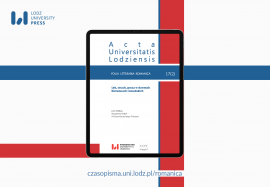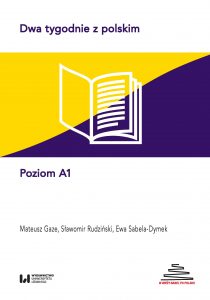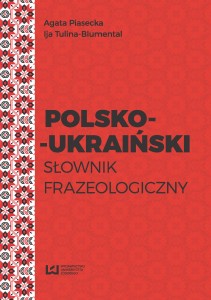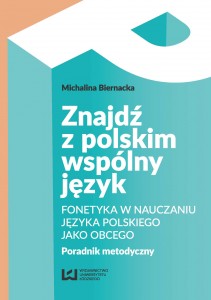Acta Universitatis Lodziensis. Folia Litteraria Romanica | T. 17 Nr 2 (2022)
Opublikowano: 29 czerwca 2023

Motywem przewodnim nowego Acta Universitatis Lodziensis. Folia Litteraria Romanica jest: Lęk, strach, groza w dawnych literaturach romańskich.
Celem czasopisma, oprócz publikowania i rozpowszechniania wiedzy z zakresu literaturoznawstwa, a także i językoznawstwa romańskiego, jest nie tylko dokumentowanie rozwoju polskiej romanistyki, zwłaszcza działalności akademickiej, wydawniczej i kulturowej, ale także ważnych wydarzeń naukowych. Służą temu między innymi publikowane na łamach czasopisma recenzje książek i monografii czy sprawozdania z konferencji naukowych.
Podstawowym językiem publikacji jest język francuski, chociaż niekiedy ukazują się wydawnictwa w innym języku romańskim lub w języku polskim.
Punktacja MEiN: 40 punktów (grudzień 2021).
Strach jako narzędzie władzy w pismach historiograficznych Tacyta
Marta Czapińska-Bambara
Tacitus’texts are permeated with fear. This effect is reached as a result of the use of a rich vocabulary related to fear and numerous scenes in which fear plays a major role. The structure of Tacitus’stories is in fact composed of the overlapping kinds of fear caused and felt by people in power, participating in its execution, aspiring to hold it and subjected to it. Consequently, the stories expose the mechanism of Roman power, which was driven and fueled by fear. The reason why Tacitus used the description of fear in the historical texts also seems to be significant. The aim of this article is therefore to look at the semantic layer of the words that the historian used to illustrate fear, to emphasize the aspect of power within interpersonal relations, which were almost entirely based on fear, and to indicate the reason that could have prompted Tacitus to use this feeling in presenting the history of Rome.
Joi jako źródło niepokoju we wspólnotach emocjonalnych trubadurów i trobairitz
Michał Sawczuk-Szadkowski
This paper aims to analyse the courtly love of the troubadours with a particular focus on the relationship between joi and fear or disquiet. With the background of previous concepts, the model of fin’amor as an emotional community with its basic characteristics is presented. On the example of selected texts from the courtly literature, a “map of emotions” of the troubadour world, in which joi plays a central role, is constructed. Joi is defined as “joy acting” or “a state of harmony, ecstasy and inner perfection”. As the etymology of this concept, it is taken as a combination of the words gaudium (joy) and joculum (play). The analysis indicates that the pursuit of joi is both the reason for building the emotional community of fin’amor and the goal of its actors involved. The achievement of joi is based on an elaborate system of literary games. In the emotional community, joi triggers other emotions, including fear and disquiet. Thus, joi is not a state of inner harmony but an ambivalent entity, affecting both the well-being of the individual fin’amor actors and the lack thereof.
Literacki obraz strachu w Rolandslied Pfaffe Konrada w kontekście Chanson de Roland
Joanna Godlewicz-Adamiec
The literary work Rolandslied, written at the end of the 12th century by Pfaffe Konrad, most probably at the behest of Henry the Lion, is a transformation of the history known from the French literary work Chanson de Roland, written three quarters of a century earlier. It is an interesting example of adjusting French patterns to the expectations of recipients at German courts. In the epilogue he added, Konrad takes up the topic of the relationship between his version and the French one. This article carries out the comparative analysis, in the line with the trend of the humanities of affects, is an attempt to answer many research questions. Why in Konrad’s work the opposition of attitudes is depicted precisely with the help of fear, and can the source for such an approach be found in earlier models? What explains the important role of fear in the key scene of this literary work? What literary strategies are developed according the theme of fear? What are the sources of these strategies?
Lęk przed karą jako czynnik motywujący postępowanie bohaterów w chansons de geste z cyklu baronów zbuntowanych
Alicja Bańczyk
The article shows, how the fear of punishment influences the activities of protagonists of four French medieval epic poems (chansons de geste): Renaut de Montauban, Girart de Roussillon, Raoul de Crambrai and Chevalerie Ogier. Firstly, the basic notions, such as fear, anxiety and punishment are defined. Then, the presentation of penalties following infringement of divine law follows. Also, the public law penalties such as confiscation of fief or disgraceful penalties for knighthood such as hanging, or mutilation are shown. Secondly, the article proves that the perspective of punishment often appears in the analysed epic poems. The protagonists are frequently reminded of the perspective of penalty by external factors, usually by remonstrating vassals. The reference of penalty usually causes no protagonists’ fear, despite expectations. Thus, the rebellious vassals consider the perspective of being punished by their activities.
Diabeł straszniejszy niż go malują. Lęk przed diabłem w XIII-wiecznym zbiorze Vie des peres
Joanna Gorecka-Kalita
The article analyses the vision of the devil in the selected tales of the Vie des peres, a collection of pious tales from the thirteenth century, freely inspired by patristic literature and medieval exempla. The period in which the collection was written, the thirteenth century, bridges the gap between the early and late Middle Ages: it is a time when the perception of the devil is changing, and he is becoming increasingly feared. The analysis focuses mainly on four stories in which the devil is at the centre of the story, and in which his very image is a source of fear and a key element of the story: ‘Devil’s Mouth’, ‘Devils Vision’ and two versions of ‘Devil’s Image’. The vision of the devil in these stories coincides with the teratological vision that is dominant in the iconography, to which the stories directly allude. The message of these stories is generally positive: the protagonists almost always manage to overcome their fears and free themselves from the power of the devil. In this way, the authors avoid the trap of Manichaeism: the devil, despite his cunning and sophistication, is in the end only a caricature of an angel, unable to oppose God effectively. The fear of the devil appears several times on the pages of Vie des peres, but it is the message of hope that dominates.
Miłość i strach w Dekameronie Giovanniego Boccaccia
Anna Gallewicz
In the Introduction to the First Day of the Decameron Giovanni Boccaccio depicts the Black Death pandemic and also portrays the devastating effects of death on emotional states of Florentines. Although the plague doesn’t enter the artistically ordered world of the Decameron’s storytellers, death and fear are still present in the novellas. Therefore, a question may arise, how is it possible that the novellas which were written to bring comfort often show dramatic events? To approach this issue the article aims to examine various relations between love and fear. It turns out that in the reconstruction of the world devastated by the plague, it may be helpful, among other things, to return to the ancient chivalrous values and the concept of courtly love, which only noble individuals can truly experience. What is important, nobility of spirit according to Boccaccio is not determined by either gender or social origin.
Groza konfliktów religijnych we Francji w Kronice Pierre’a Belona du Mans (1517-1564)
Dorota Szeliga
PIERRE BELON, naturalist and traveler of the 16th century, known for his publications in the field of botany and zoology, and above all for his account of the voyage to the Levant (1546-1549), is also the author of the Cronique, unpublished in the sixteenth century. This polemical work describes the events of the beginning of the French Wars of Religion that Belon witnessed. It consists of a speech addressed to King Charles IX and two accounts of the sieges: that of Moulins imposed by the Huguenots and that of Bourges by the royal army. The Cronique is an important source of information on the religious and political conflicts between Catholics and Huguenots. The article presents the historical context of the events described by Belon as well as the circumstances of the creation of the work. The selected fragments show issues addressed by the author such as the horror of religious conflict, the horror of war, the fear experienced by the people and the apocalyptic vision of the future of France. Although Belon was first and foremost a doctor and naturalist, he showed great interest in the language and coined many neologisms that defined the Huguenots and their activities. The value of the Cronique resides above all in the fact that, thanks to the observations it contains, it makes it possible to better understand the atmosphere of the tragic period of the fratricidal wars in France.
Motyw szafotu w Tragédie française à huit personnages (1571) Jeana Bretoga
Karolina Kasperska
The text written by Jean Bretog Tragédie française à huit personnages (1571) is, like its Normandy author, still unknown to a wider group of specialists. This drama, through its moralizing and allegorical character, derives from and inscribes itself in the tradition of medieval morality plays and mysteries. At the same time its subject matter focused around l’homme coupable and the punishment imposed on it, and the dominant poetics of l’exhibition de la violence, it is a harbinger of the theatrical aesthetics of baroque. Characteristic feature of mentioned period is, among other things, the lack of resistance to dazzle with cruelty. This article will focus on the scaffold motive present in the piece, related issue of boundaries and the possibility of presenting brutal and cruel events on the stage, as well as their engagement and influence on main character. The analysis will concern the descriptive and representative dimension of the motif.
Strach jako narzędzie władzy w Antymakiawelu Innocentego Gentilleta
Paulina Materka
This article explores the issue of fear as an instrument of power in Discours sur les moyens de bien gouverner by Innocent Gentillet. This protestant author was a witness to the St. Bartholomew’s Day massacre, which he blamed on Machiavellians. In his book, Gentillet enters into polemics with Machiavelli’s The Prince. He opposes the ideas proposed by the Italian and gives many counterarguments. As for fear, he evokes a maxim of Machiavelli’s that the Prince can be cruel if he is obeyed, whereas, for the Frenchman, cruelty is the cause of fear, and with the help of historical examples he proves that the cruel Prince cannot govern for long. The second aspect on which the author focuses is the relation between love and fear. Gentillet disagrees with the Italian author who says that it is impossible to pot both so it is better to be feared than loved. Innocent Gentillet’s discourse follow the anti-Italianisme of the time.
François de La Noue czyta Amadisa z Walii
Witold Konstanty Pietrzak
Amadis de Gaule is a chivalric romance adapted from the Spanish work of Garci Rodriguez de Montalvo by Nicolas Herberay des Essarts in 1540-1548. As the first bestselling novel in France, it initially generated enthusiastic reactions concerning the qualities of style and the pleasure of reading, then, with the progress of violence unleached by civil conflicts, more and more severe. François de La Noue, famous soldier sincerely devoted to the Protestant cause and author of Discours politiques et militaires, is one of the most intransigent censors of the French Amadis. In this paper we show the poisons that according to the Huguenot infect the fiction of this novel: tantalizing depictions of mages and witches, immoral conception of love relationships and fanciful military exploits of the characters. These three layers of the work risk perverting French youth, which plunges the moralist in deep concern.
Fobie w szesnasto- i siedemnastowiecznym dyskursie medycznym we Francji
Magdalena Koźluk
From the point of view of the ancient medicine, apprehension, which is a feeling of fear and uncertainty regarding the probable outcome or consequences of something, significantly tormented the soul rather than the human body. Altogether with anger, hatred, and yearning, it was classified into the serious diseases, called by the physicians “perturbations of spirit” (perturbationes animi). The regimina sanitatis genre provided all the information about them. In this article, we presented a type of the apprehension which today we would term a phobia and describe it as a neurotic disorder. Firstly, we concentrated on the place of the apprehension amongst the other sicknesses of the soul. Secondly, we investigated two kinds of fear, its sources, and its peculiar symptoms. Finally, we depicted a few cases of phobia (musophobia, ailurophobia, hydrophobia, batophobia, etc.) rarely mentioned in the sixteenth- and seventeenth-century medical discourses.
Opanować strach – wątki dramatyczne w Astrei Honorégo d’Urfé
Maja Pawłowska
L’Astrée, a pastoral novel of Honoré d’Urfé abounds in dramatic episodes that shatter the bucolic idyll. The suicide scenes of Damon or Chriséide; the violent context of Placidie’s marriage show the protagonists in traumatic situations. However, they all keep their cool, preferring to act instead of lamenting. Thus Honoré d’Urfé shows readers how to survive dramatic situations. He wrote his novel for readers who had mostly survived the nightmare of religious wars, who were no strangers to dramatic choices, the imminence of death, and who realized that in a critical situation, It was not fear, but action and pragmatism that could save their lives. D’Urfé is an excellent teacher. In the pastoral novel, by confronting its heroes with dramatic choices, it shows readers what kinds of actions are rational and effective, and how life differs from literature.
Czego się bać w baśniach bez duchów i potworów? Rozważania o literackiej baśni francuskiej końca XVII wieku
Monika Kulesza
Between 1690 and 1715, the literary fairy tale, the conte de fées, becomes fashionable in France, created by the regulars of Parisian salons and distinct from the folktale. The monster in the modern fairy tale is ridiculed, so that the fear it is supposed to inspire is apparent (the example of the tales of Madame d’Aulnoy and de Murat). Then, in two fairy tales (Le prince rosier by Catherine Bernard and Anguillette by Mrs de Murat), I analyse fears and anxieties that are rooted in love rather than evil spells. The pessimistic vision of love links the fairy tale with the novel of the late 17th century. Both are meant to transport the reader to another, distant world in order to portray the real world all the better. Contes de fées create an atmosphere of spiritual anxiety that has no connection with the enchanted world: no supernatural powers change human nature and the misery it leads to, and the sophisticated form and magical setting hide the true face of the world of feelings.
Sceny strachu, czyli lazzi di paura w komedii dell’arte
Jolanta Dygul
Lazzo is a short scene of a comic nature that can be compared to a modern-day gag. Italian actors had various categories of such scenes in their repertoires (mimic-gestual, acrobatic, verbal or mixed). Such a ready-made stage sequence was suitable for editing into various plots. The purpose of this paper is to analyze scenes of fear in selected scenarios dell’arte. To illustrate the variety of fear scenes improvised by Italian actors, four scenarios were chosen to adapt a single literary text, Calderón de la Barca’s La dama duende, a very popular work in the 17th and 18th centuries (La Dame Diablesse, manuscript from the Bibliothèque Nationale in Paris; La dama Demonio, manuscript from the collection of the Vatican Library; La dama creduta spirito folletto from the Neapolitan collection; La dama demonio e la serva diavolo from the collection of arguments of the court of August III).
Obraz wampira w traktacie Augustina Calmeta i innych tekstach francuskich przełomu XVII i XVIII wieku
Łukasz Szkopiński
Although they made their spectacular literary appearance with the arrival of Romanticism, vampires were arousing a vivid interest well before the 19th century. At first, the present paper will briefly review the vampire motif in French texts from the second half of the 17th and the beginning of the 18th c., such as the articles published in Mercure Galant in 1793 and 1794 or the travel narratives published by François Richard (1657), Paul Lucas (1704) and Joseph Pitton de Tournefort (1717). Afterwards, Traité sur les apparitions des esprits et sur les vampires ou les revenants de Hongrie, de Moravie, etc. [Treatise on the Apparitions of Spirits and on Vampires or Revenants of Hungary, Moravia, et al.] (1751) by Dom Augustin Calmet (1672-1757) will be analyzed in order to examine the way in which the Benedictine tackles this controversial subject in his book. The article closes with some thoughts on the reception of the treatise after its publication and its importance for the creation and consolidation of the subsequent concept of the vampire.
Między lękiem a koniecznością: motyw wojny w utopiach XVII i XVIII wieku
Stanisław Świtlik
The war seems an inappropriate element in the commentary on utopian texts. Yet it is one of the recurring motifs in fictions about Elsewhere in the 17th and 18th centuries. In the article, through famous works as well as those little known, we try to sketch the place and role of the warrior motif in the representation of fictional worlds and in the narrative construction. In the 17th century, it is only a question of the allusions and discreet mentions of the experience of the war which express the fears of the Utopians against the European conquerors. On the other hand, in the 18thcentury we observe the appearance of warlike episodes which are part of the storyline, which expresses the hold of the novel on the traditional model of utopia. War then becomes a necessity to accomplish a radical change undergone by the utopian community.
Bać się czy obawy budzić? Uczucie strachu w Historyi rozbicia się i niewoli Pana Brysson
Małgorzata Sokołowicz
The present paper focuses of the feeling of fear described in A Historical Narrative Of The Shipwreck And Captivity Of Mr. De Brisson (1789) written by a French colonial officer who – in 1785, on his way to Senegal – shipwrecked and then spent 14 months in captivity of African tribes living on the borders of the kingdom of Morocco before convincing his masters to accompany him to Mogador and exchange for a ransom. Given the theme of the book, the fear plays an important role in the text. Yet – contrary to expectations – Brisson is rarely afraid, unlike other Europeans who survived the shipwreck and – what is more – he manages to inspire fear among Moroccan tribes. The paper is divided into three parts. The first shows how Brisson talks about his own fears. The second indicates how he portrays the fear of other Europeans and the third one focuses on the fear Brisson causes among nomads.
Cyjanofobia: Sinobrody od Perraulta do Ben Jellouna
Ewa Kalinowska
The story of Bluebeard belongs to the fairy tales written by Perrault, which in later times have seen almost countless travesties – in literature, film, opera and others. This article attempts to make a comparative analysis of three French-language literary versions of Bluebeard – from the early classics (Charles Perrault), through the classics of the turn of the nineteenth and twentieth centuries (Anatole France), to modern times (Tahar Ben Jelloun). The reasons for the fear present in the story have changed over the centuries, from fear for one’s own life to fears related to the disturbance of the social order.
Ethos w paratekście Teatru różnorodnych umysłów świata Tommasa Garzoniego na podstawie francuskiego przekładu Gabriela Chappuys
Paulina Materka
This article explores the question of ethos in Theatre de diverses cerveaux du monde, text written in 1583 by Tommaso Garzoni and three years later translated from Italian into French by Gabriel Chappuys. The book is a collection of satirical speeches, in which the author praises or condemns different types of “brains”, i.e. character traits. The ethos, or the author’s self-creation in the work, takes a very specific form; it is not only the man of letters who speaks, but also the Theatre that appeals to its spectators. The allegory of the theatre used by Garzoni introduces a satirical dimension, which becomes a tool to criticise certain attitudes. In Chappuys’ translation the book acquires a new dimension; not only satirical, as in the Italian work, but also moral.
Ikonograficzne metamorfozy „złotych” mitów w malarstwie europejskim od piętnastego do siedemnastego wieku
Klaudia Kościan
In this paper we analysed the Greek myths exclusively in terms of presence of the motifs of gold, both as the main narrative thread, and as an attribute of the selected characters. Firstly, we found the sources of inspiration for the painters, which came not only from the ancient literary tradition, but most of all from the modern encyclopaedic sources, as well as compendiums of symbols and hieroglyphs. Secondly, we analysed several selected paintings of Italian, French and Dutch masters ranging from fifteenth to seventeenth century for gold as a symbol of the hybris, victory and desire. Finally, we answered to the question of what the diversity of gold symbolism consisted. The gold ant its colour is therefore the essence of considerations, not only because of the gold’s status in the old culture, but also because of the metamorphosis of its symbolic meanings in modern Europe.
Se garder de la tyrannie de la peste en France (XVIe-XVIIe siècles)
Magdalena Koźluk
Prolongeant les recherches actuelles sur les pandémies en Europe et en particulier dans la France des XVIe et XVIIe siècles, nous nous sommes proposés d’examiner dans le présent article les recommandations médicales qui visaient à protéger les patients des épidémies de peste. En nous appuyant sur les régimes de santé et sur les traités de pestes de l’époque, nous avons analysé les instructions proposées par les médecins, chirurgiens et apothicaires, pour mener une vie saine, vertueuse et préservée de la maladie. Dans la première partie, nous avons rappelé au lecteur contemporain les fondements et théories de l’ancienne médecine qui, sur la base d’un système complexe et cohérent, privilégiait le « juste milieu » et la sobriété. Dans la seconde partie, nous avons regroupé les diverses prescriptions prophylactiques relatives aux six choses non-naturelles en nous concentrant sur le manger et le boire, le mouvement et le repos, l’évacuation des humeurs superflues et la conduite des passions.
Wstęp
Witold Konstanty Pietrzak
Komentarze
Ten post dostępny jest także w języku: angielski





